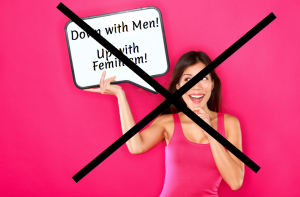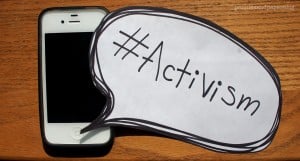
The chest of someone wearing a suit, with another person behind them pulling on their tie in a sensual gesture. Source: Huffington Post
Can women objectify men?
That’s a question that gets asked a lot in feminist circles. And the answer isn’t always easy.
Viewing it simply, one would think that the answer is yes.
Because if we define sexual objectification as seeing people as no more than the sum of their parts and what those parts can do for us sexually, then yes, of course women can objectify men.
After all, there are women out there who “use” men for sex with little regard to their feelings, personalities, or desires, just as men do to women.
And this recent ad from Kraft is just one example of a new trend in advertising known as “hunkvertising.”
Obviously these men — the ones being used for sex and the ones laid out in all their naked glory for the viewing pleasure of us ladies — are being objectified, right?
Unfortunately, it’s not as simple as that.
The Difference Between Sexual Objectification and Sexual Desire
Sexual objectification and sexual desire are two different things.
Sexual desire and attraction is a normal and natural part of life. It involves two (or more) people stating their desire for one another and consenting to mutually agreed-upon sexual activity.
So in the case of someone “using” the other for consensual sex, it’s not true objectification because both parties have agreed (hopefully!) to engage in the act.
Sexual objectification, however, puts one person in the role of subject and the other person in the role of object. In heterosexual coupled relationships, these roles are usually assigned to the man and woman, respectively.
Sexual objectification requires that one person choose what they want sexually and the other person is required to perform to their standards.
And this kind of thinking permeates our culture so deeply that sometimes we don’t even recognize it.
To understand how objectification works, we have to start at the societal level.
Sexual Objectification as the Status Quo
The status quo of sexual objectification places the man as the subject and the woman as the object.
This idea has been so ingrained in society that it’s become part of our everyday culture. Sexual objectification is everywhere.
We see it in the form of everyday advertising — companies use scantily clad female models to sell their products (and we see this in both men’s and women’s magazines).
We see it on TV: Female characters (even powerful ones, like hospital administrator Dr. Lisa Cuddy on the show House, M.D.) wear low-cut shirts and tight clothing, while their male colleagues dress in normal business attire or loose clothing.
It even shows up in our everyday actions, like when we tell girls in schools to dress a certain way to avoid “distracting” their male peers.
So even though male objectification occasionally occurs (usually in the form of advertising), we can’t forget the context within which this operates.
Often, male objectification is done in the form of tongue-in-cheek references to ads that have objectified women for centuries.
And even if it’s a man being objectified in an ad, he is usually shown in full form with complete awareness of his presence, unlike women who are often shown with heads missing or from the back, effectively dehumanizing them.
Objectified men in ads seem to be saying, “Come hither; look what I can give you,” while objectified women seem to be saying, “This is yours for the taking.”
Reverse Sexism?
Even if a man is objectified on occasion, it is not the same thing as living within its oppressive structure day in and day out.
It’s akin to white people saying that reverse racism exists: It just doesn’t — because white people have never experienced systematic, centuries-long oppression like people of color have.
And men haven’t experienced systematic, centuries-long objectification like women have.
Is it possible for men to feel affronted or even demeaned when women comment on their chiseled chest, six-pack abs, or large penis? Of course. Just like it’s possible for a white man to feel offended when a black woman calls him a cracker.
But those instances are not nearly as common, nor do they contribute to a larger system of oppression like sexism or racism. If we refer to those insults as oppressive, then we’re reducing system-wide, institutionalized objectification and racism to petty, interpersonal slights.
Or, as Jamie Utt says in his amazing article “’That’s Racist Against White People!’ A Discussion on Power and Privilege”:
“We need to recognize that not all hurtful words or deeds are equal when certain ones are backed by a history and current system of domination, violence, oppression, repression, dehumanization, and degradation.”
Sexual Objectification and Its Role Within Misogyny
Not only is sexual objectification part of the status quo, it also plays a role in the underlying current of misogyny that courses through our society.
Misogyny is defined in many dictionaries as the “hatred of women,” but it’s much more complex than that. It’s dehumanizing.
Misogyny denies that women have thoughts, feelings, and rights. It robs them of everything that makes us human.
And when we reduce women to the sum of her parts — that’s misogyny. We are effectively saying that her thoughts, feelings, and opinions don’t matter. All that matters is her body.
When we use her for sexual purposes only and cast her aside, we are dismissing her worth as a person.
This simply does not happen to men — at least, not at the same level. Because there’s no system of oppression in place for men like there is for women.
Again, that’s not to say that women can’t use men to satisfy their sexual needs only.
But it falls more under the realm of awkwardness and less under the umbrella of objectification and oppression.
***
So is it possible for women to objectify men?
Possibly — at the micro, interpersonal level.
But since sexual objectification is so intertwined within our culture and within misogyny, it would be a falsehood to say that it occurs against men at the same level that it does against women.
In the end, all arguing, “Hey, women objectify men, too!” does is distract from the real problem — deeply ingrained, misogynistic, sexual oppression against women.
[do_widget id=”text-101″]
Shannon Ridgway is a Contributing Writer to Everyday Feminism from the great flyover state of South Dakota (the one with the monument of presidential heads). In her free time, Shannon enjoys reading, writing, jamming out to ’80s music and Zumba, and she will go to great lengths to find the perfect enchilada. Follow her on Twitter @sridgway1980. Read her articles here.
Search our 3000+ articles!
Read our articles about:
Our online racial justice training
Used by hundreds of universities, non-profits, and businesses.
Click to learn more
Most Read Articles
- « Previous
- 1
- …
- 30
- 31
- 32



















